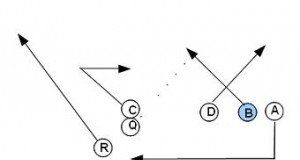Flag Football (Basics You Should Know) – Terms, Rules, Flag Belts, Blocking And Ball Kicks
Interested in learning more about flag football? You’re in the right place!
In the following sections, we’ll cover the fundamentals of the game, including its structure and essential terminology.
First – Team Structure
- Teams require 7 players, with a minimum of 5.
- At the snap, the offensive team must have 4 players on the line of scrimmage.
- During timeouts and within plays, players can make substitutions.
- Players must sign a roster or waiver form before participating.
- Team areas are located within the 20-yard lines and 2 yards off the sidelines, accommodating a maximum of 2 coaches and all players.
- Set spectator areas 5 yards from the sidelines, and prohibit spectators from entering team areas.
Second – Facilities and Equipment
- Shoes are mandatory for all players.
- Cleated rubber shoes are permitted, but not hard-soled, open-heel, open-toe, or metal cleats.
- Players cannot tape pockets or turn shorts inside out, nor wear shorts/pants with pockets or belt loops.
- Towels may not hang from participants’ waists to avoid interference with flag removal.
- Knot-free flag belts are required; knotted belts can result in player disqualification.
- Teams must provide their own footballs without specific requirements for markings or pressure.
- Men can use regulation-sized footballs, while women may use junior, youth, or intermediate sizes.
- Officials may inspect the footballs for legality before play.
- Players are not allowed to wear hard and unyielding materials, including jewelry, casts, braces, pads, bandanas, helmets, and billed hats, above the waist.
- Teams must wear matching colored shirts, and these shirts must either be tucked in or cut 4 inches above the waistline.
- Players are not allowed to wear hooded sweatshirts.
Covering Flags
- Teams receive 2 warnings before officials enforce a 10-yard penalty.
- Flags must be provided by intramural sports.
Third –Timing and Game Start
- The referee and team captains will conduct a coin toss to determine which team will choose between starting on offense or defense, or selecting a goal to defend for each half.
- The captain who wins the coin toss is permitted only one of these two choices.
- Each team permits 2 timeouts per half.
- Players must put the ball into play within 25 seconds after the official places it.
Timing Structure
- The game consists of two 20-minute halves, with a 3-minute halftime.
- Continuous timing governs the first half of play. In the second half, continuous timing applies for the first 18 minutes.
- The clock will stop at the 2-minute mark before the end of the second half. The referee will inform each captain of the remaining time.
Mercy Rules
- If a team leads by 50 points at halftime or by 19 points in the last 2 minutes of the game, officials will stop the game.
Attempt to Waste Time Illegally
- If a team attempts to waste time with a false start, the referee may start the clock at the snap if the team is consuming too much time.
Rules of the Game
- The field dimensions are 80 yards long, 40 yards wide, with 10-yard end zones.
- Officials establish markings every 20 yards.
- After each touchdown, officials place the ball on the 14-yard line..
- Teams have 4 downs to advance to the next zone line.
- The zone line ahead of the ball is the target, unless there’s a distance loss due to failures or penalties.
- If a team reaches the next zone, officials award them a new series of downs.
Removing Flag Belts
- The down concludes when the defender removes the runner’s flag belt.
- The ball is placed at the spot where the flag belt’s clip is detached.
- If a flag belt falls off, a one-hand tag between the knees and shoulders counts as a capture.
- Players may leave their feet to remove a flag.
The Ball is Dead If
- A legal flag removal occurs.
- The ball carrier touches the ground with any part of their body other than their feet or hands.
- The ball touches the ground after the snap from the center.
- Snaps from the center that touch the ground (officials’ discretion).
Additional Information
- All offensive team members can receive a pass unless a player has run out of bounds during the play.
- Centers cannot change the ball’s position or simulate the start of a play once they have taken a position for the snap and adjusted the ball.
- Players must snap the ball in a single continuous motion.
- Officials may approve the movement of the ball due to poor field conditions.
- Players receiving a snap must be 2 yards behind the line of scrimmage during a scrimmage play and 1 yard from the scrimmage line.
- Offensive players must come to a complete stop for at least 1 second before the snap. Allow only one offensive player to be in motion, who cannot move toward the opponent’s goal line at the snap.
- If two or more players are in motion before the snap, it is considered a shift, and all players must be set for at least one second before the snap.
- For a catch to be legal, pass receivers must come down with at least one foot in bounds.
Rush
- Defenses must line up at least one yard from the scrimmage line, even if the offensive team is within one yard of the end zone or the gain line.
- An offensive player must be within 15 yards of the ball. To prevent “hideout” or “sleeper” players, teams should clearly identify the seven offensive players on each play, with violations resulting in a 10-yard penalty for illegal participation.
Fumbles
- A fumble is dead when the ball hits the ground.
- Officials place the ball at the spot where it touched the ground.
- Players who catch fumbled or passed balls that remain in the air can advance them.
- A fumble into the offensive team’s end zone results in a safety, while a fumble into the opponent’s end zone may result in a touchback.
- After a safety, officials place the ball on the 14-yard line, and the team that received the safety points puts the ball into play.
- Following a touchdown, officials place the ball on the 14-yard line after a touchback, and it is put into play for a new series of downs.
Attempts for Extra Points
- Attempts start at the 20-yard line. Tries for 2 points are taken from the 10-yard line, and tries for 1 point start at the 3-yard line.
- If the defense intercepts a pass during an extra point attempt, they can return it for 1 score, which equals 3 points.
Playoffs – Tie Scores at the End of Regulation
- In the event of a tie, field captains will meet for a coin toss, as there are no regular overtime periods.
- The coin toss winner chooses either offense or defense. If additional overtime periods are needed, the choice alternates between teams.
- Each team gets 4 downs from the 20-yard line to score a touchdown. If Team A scores, Team B then has 4 downs to attempt to win or tie the game.
- If the defense intercepts the ball and returns it for a touchdown, the game ends. If not, officials place the ball at the 20-yard line to start the 4-down series.
- Each team may use one timeout per overtime period
Fifth – Blocking
- Blocking, as in tackle football, is prohibited. Additionally, screen blocks are permitted only without contact.
- Players are prohibited from initiating a screen block with elbows, legs, hands, arms, or the body.. Players may use their arms only to break a fall or maintain balance.
- Players must remain on their feet while performing screen blocks.
Sixth – Flag Belt Removal
- Defensive players may attempt to remove flag belts by touching the opponent’s body with their hands. However, they cannot hold, kick, or push the ball carriers down to remove the flag.
- Players cannot steal the ball, trip opponents, make contact with opponents on the ground, or engage in unnecessary contact. Additionally, intentional diving or running into opponents is prohibited and may result in a personal foul or a 10-yard penalty.
Seventh – Ball Kicks
Offensive Team
- Before a punt, it must be announced, and the offensive “kicking team” should have 4 players on their scrimmage line, with the center being the designated spot for the snap.
- Punters must stand 2 yards behind the scrimmage line when receiving a snap. They must punt the ball immediately, and offensive players are not allowed to move before the ball is kicked to avoid a 5-yard penalty.
Defending Team
- Prohibit defenders from entering the neutral zone before a punt.
- The receiving team can advance the ball after it touches the ground, but if it hits a player before touching the ground, officials consider the ball dead.
- Teams do not permit fake punts and quick kicks.
- After a punt, members of the receiving team can attempt to block the punt.
- If an offensive player behind the scrimmage line recovers a blocked punt, they may advance the ball.
Additional Reading:










I didn’t know that you need a team of 7 players in order to play flag football. My son has been interested in starting a flag football team with his brothers, but he doesn’t have enough people to form an entire team, he needs to find more people who would be interested. It may be a good idea for us to find a company that helps with developing a football team.